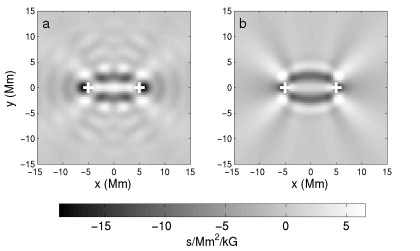
|
Science Highlight May 2006
|
 |

|
Science Highlight May 2006
|
 |
Finite-wavelength tomography of the Earth or the Sun critically relies on models of the sensitivity of seismic travel times to localized heterogeneities, as evidenced by the controversial discovery of plumes in the Earth's mantle.
We have used time-distance helioseismology to directly measure the spatial sensitivity of surface-gravity wave travel times to magnetic perturbations. The data strongly speak in favour of 'banana-doughnut' theory according to which body-wave travel times are sensitive to the wave speed in a broad region surrounding the geometrical ray path.
The solar surface magnetic field is dragged by convective motions into concentrations that form the quiet-Sun magnetic network. Because these magnetic features are smaller than the wavelengths of solar oscillations, they are ideal to study the response of finite-wavelength seismic travel times to point-like perturbations.
We used 400 hours of high-resolution images of the solar line-of-sight magnetic field and of the line-of-sight velocity obtained in 1996-97 by the MDI/SOHO space telescope. We measured the positions of the most localised magnetic features in each 4-hour interval. On average, these features have a width of 2.6 Mm. The velocity images (one per minute) were used for seismic analysis. Solar surface-gravity waves, which propagate horizontally in the top 2 Mm beneath the solar surface, have a dominant wavelength of 5 Mm.
We measured surface-wave travel times between any two locations separated by a fixed distance of 9.9 Mm.
In order to reduce random noise, the travel-time maps were shifted, de-rotated, and averaged over all the magnetic features to obtain a map of the travel-time sensitivity to a local magnetic perturbation. Figure 1a reveals that the sensitivity is not restricted to the geometrical ray path, is spread on an ellipse, and oscillatory.
By studying the interaction of seismic waves with localised magnetic features on the Sun, we have provided an observational confirmation of the basic banana-doughnut theory originally developed for finite-wavelength tomography of the Earth. This is the first test outside the laboratory showing the relevance of scattering theory to cross-correlation travel times (laboratory tests exist for ultrasonic waves). As in Earth seismology, we suggest that finite-wavelength modelling will be essential in revealing deep structures in the solar interior, including those related to the solar dynamo.
 Figure 1: Sensitivity of solar surface-wave travel times to small magnetic features.
Figure 1: Sensitivity of solar surface-wave travel times to small magnetic features.
(a) Observations based on data from the high-resolution field of view of the MDI-SOHO space telescope. A magnetic feature at position (x,y) causes a shift in the travel time measured between the two observation points (crosses). The grey scale gives the shift in travel time due to a one kilogauss magnetic field covering one square megameter.
(b) Phenomenological model for a point magnetic scatterer based on banana-doughnut theory. A scatterer located anywhere along an ellipse (with focii at the observation points) causes travel-time shifts of the same sign, giving rise to Fresnel zones. The hyperbolic features are due to the scattering of waves generated by distant sources.
Duvall T.L., Birch A.C., & Gizon L.
![]() Direct measurement of travel-time sensitivity kernels for helioseismology
Direct measurement of travel-time sensitivity kernels for helioseismology
Astrophysical Journal, in press, 2006
| © 2009, Max Planck Institute for Solar System Research, Lindau |
Laurent Gizon 19-05-2006 |